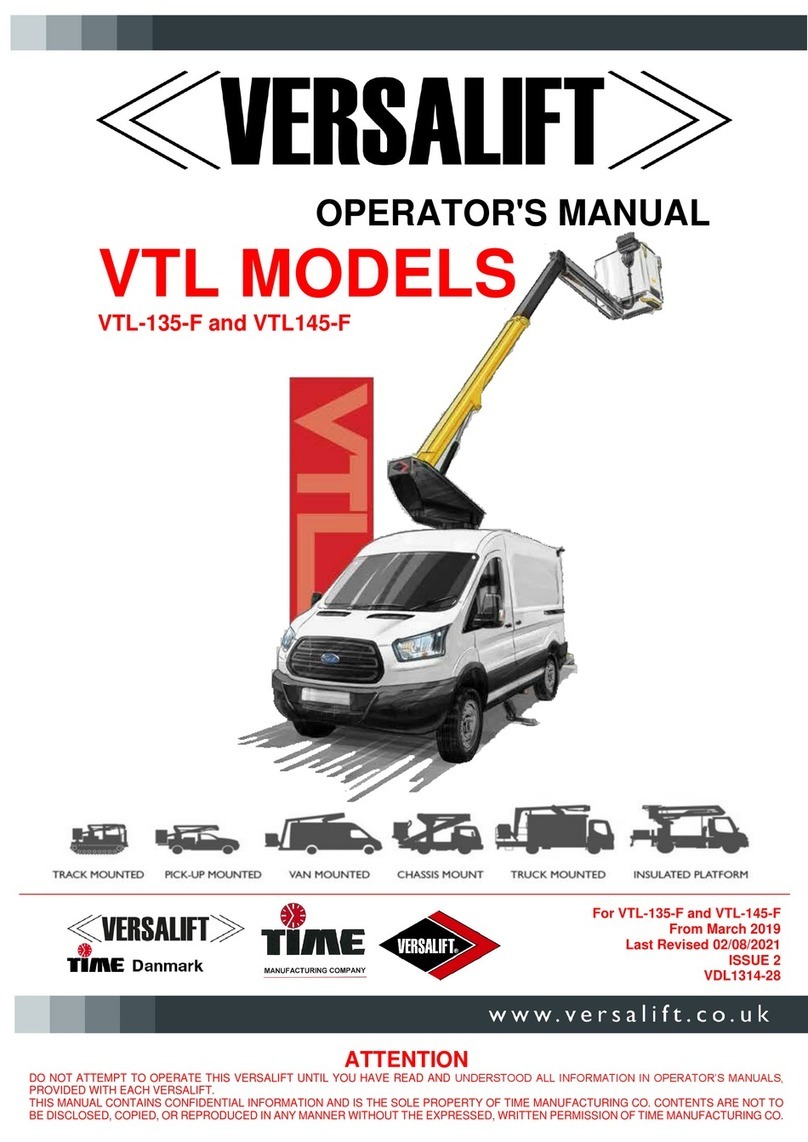
1-1 39014-03 06/16VERSALIFT VST-36/40/47/52-I
INTRODUCTION
The Versalift aerial device has been designed and
engineered to conveniently place personnel at work
stations above the ground. This aerial device, as
manufactured, meets or exceeds all applicable ANSI
A92.2. Full controls at the platform and complete
freedom of boom movements make the Versalift a
truly flexible and functional work platform.
NOTE: As the aerial device users, you must read,
understand, and follow the instructions in this
manual and other manuals supplied with this
aerial lift unit.
This manual is furnished to provide practical and
essential information for efficient operation of the
Versalift aerial device. Proper operation of this aerial
lift is the responsibility of the operator and requires a
thorough understanding of its capabilities. Personnel
responsible for the operation of the aerial lift must be
familiar with and understand this manual.
In addition to, dealers, owners, operators, renters,
lessors and lessees are required to comply with the
requirements of the applicable section or sections
found in ANSI A92.2.
NOTE: For additional safety information and
required responsibilities, refer to the
accompanying EMI Safety Manual and Manual
of Responsibiltities.
Detailed information for the maintenance inspection
and service of the Versalift aerial device can be found
in the accompanying Service Manual. Should further
installation information be required, contact your local
Versalift dealer or Time Manufacturing Company.
DANGER: THIS EQUIPMENT SHOULD
BE OPERATED AND SERVICED ONLY BY
COMPETENT PERSONNEL FAMILIAR WITH
GOOD SAFETY PRACTICES. THIS
INSTRUCTION IS WRITTEN FOR SUCH
PERSONNEL AND IS NOT INTENDED AS A
SUBSTITUTE FOR ADEQUATE TRAINING AND
EXPERIENCE IN SAFE PROCEDURES FOR THIS
TYPE OF EQUIPMENT.
DANGER: READ AND UNDERSTAND
THIS MANUAL BEFORE ATTEMPTING TO
OPERATE THIS AERIAL DEVICE.
The manual identifies all the controls and their
locations and describes how the controls function.
Routine preventive maintenance is very important in
maintaining reliable aerial lift service. A preventive
maintenance schedule is provided and must be
understood and followed by all operators.
DANGER: THIS IS NOT MAINTENANCE
FREE EQUIPMENT.
NOTICE: THIS MANUAL IS A PERMANENT
PART OF THE VERSALIFT AERIAL DEVICE AND
MUST REMAIN WITH THE UNIT ALWAYS.
Time Manufacturing Company reserves the right
to improve the design or specifications at any time
without any obligation to incorporate new features
into products previously sold.
MANUAL STRUCTURE
This manual is divided into six, numbered chapters.
The first number in the page number at the bottom
of each page identifies the chapter number. Chapter
tabs, with titles printed on them, allow easy location
of the desired subject.
ADDITIONAL MANUAL FEATURES
Danger, caution,and warning notes are indented,
bold faced, and separated from the regular text to
emphasize their importance and the need for
attention.
English measurements are followed by equivalent
metric measurements in parenthesis.
Non-critical units of measure are usually rounded-
off to the nearest whole unit.
Notes referring the reader to related information in
the manual indicate the chapter or a section of a
chapter, not to a single page. The reader may need
to scan a few pages to find the needed information.
INTRODUCTION
THIS MANUAL CONTAINS CONFIDENTAL
INFORMATION AND IS SOLE PROPERTY OF
TIME MANUFACTURING, AND IS NOT TO BE
DISCLOSED, COPIED, OR REPRODUCED
WITHOUT EXPRESSED PERMISSION OF
TIME MANUFACTURING.





























